Now I am become Death, Destroyer of Worlds
Hari Kunzru sees in recent aggressive Hindu spiritual nationalism clear parallels with the fascist movements of 1930s Europe. Here he examines the convergence of the mystical discourse of shakti with that of nuclear force
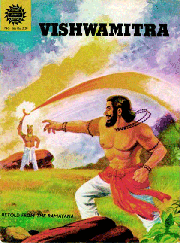
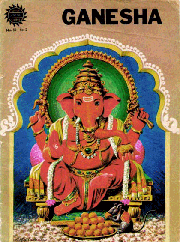
Illustrations from the Amar Chitra Katha series >Vishwamitra, Ganesha, Agastya and Karttikeya
Since Robert Oppenheimer quoted the Bhagavad Gita as he watched the first nuclear test on 16 July 1945, Hinduism has been in a nihilistic dialogue with nuclear weapons. After its own first test in 1974, the decision not to sign the Comprehensive Test Ban Treaty in 1996 and the controversial 1998 tests (to which its neighbour Pakistan immediately replied), India is now well on the way to becoming a fully-functional nuclear state. Under Prime Minister Atal Bihari Vajpayee it has developed its own intermediate range ballistic missiles and is putting in place the command and control systems necessary to turn test explosions into operational capability. Vajpayee, leader of the Hindu nationalist Bharatiya Janata Party (BJP), has been pressing for India to acquire these weapons since China’s first tests in 1964. At the time, speaking in parliament, he stated ‘the answer to an atom bomb is an atom bomb, nothing else.’
The BJP hailed the 1998 tests as the advent of a ‘Hindu bomb’ and amid euphoria at the perceived international status they gave the country, carefully presented atomic weapons within their own unique ideological framework, a perspective made up of equal parts religious mysticism, aggressive nationalism and paranoia. Nuclear weapons now lie at the heart of the BJP’s vision for India, and are seen as nothing less than the technical manifestation of a god-force or spiritual energy which underpins both political and military dominance; physics, politics and religion unified in a kind of cosmic energetics understood through the Sanskrit term shakti.
In simple terms, shakti is power. In Hinduism it is feminine, the dynamic creative energy through which the universe manifests itself, as opposed to the static substance of things, which is understood to be male. In conventional theology the union of these two qualities is represented by pairs of male and female deities, often understood as husband and wife. In a sense the male is the acting subject and the female the power of action. In the popular iconography which so fascinates and repels non-Hindus, the forest of limbs and the weapons they hold represent the multiplicity of divine attributes and the infinite ways shakti can manifest itself.
It is shakti which Hindu nationalists believe they have harnessed in India’s nuclear program. A sign by the test site at Pokhran in the Rajasthani desert describes it as the shaktishal or site of power. In 1998 extreme Hindu groups made plans to carry dust from the site to temples around the country, and to erect a ‘seat of power’ at Pokhran itself, a kind of ‘shakti-focusing’ device which would facilitate further manipulation of this spiritual-thermonuclear energy. It is no accident that the products of India’s missile program are given elemental vedic names (Agni, Prithvi) and that BJP publicity materials (and those of associated Hindu extremist groups such as the Shiv Sena and the RSS) often combine nuclear imagery (rockets, spinning atoms), religious imagery (the bow of Rama, the colour saffron) and portraiture of their leaders drawn from socialist realist and devotional iconographic traditions.
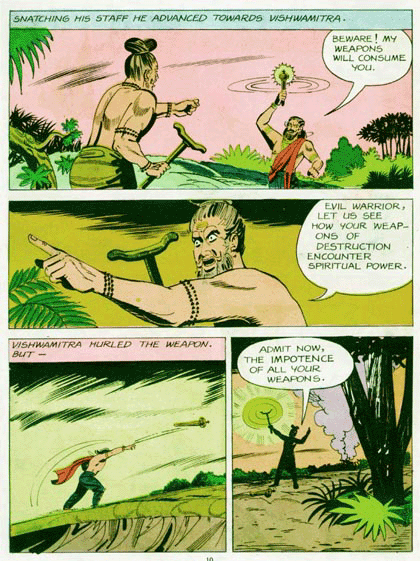
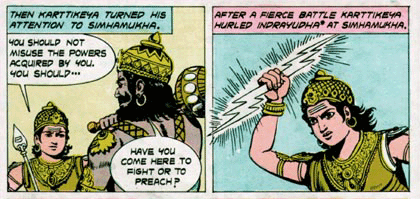
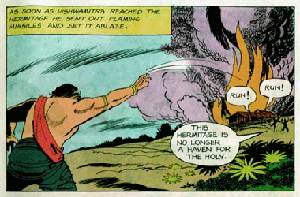
Harnessing shakti means the acquisition of political as well as technical power. The ideology of Hindu nuclear nationalism is in some ways a mirror to the Islamism of its neighbour Pakistan, where missiles have Koranic names and tests are held to pave the way for an international muslim nuclear shield, to defend against the depredations of the US. In other ways the mystical dimension of the Indian atomic imagination is unique. Hindutva, the ideology of the BJP, is the belief that the ideal society is based on a return to the ‘pure’ organic Hindu community of the Vedic period (roughly 2500BCE-200CE). In this mythical golden age, the people are imagined as having a natural connection to the soil and rivers of Bharat Mata (mother India, source of shakti) and the caste-based mode of social organisation laid out in scripture holds perfect sway. Getting back to this ideal state of things would obviously involve erasing a thousand years of Indian muslim history, not to mention that of India’s millions of Christians, Zoroastrians, Buddhists and others. The activists want this to happen sooner rather than later.
Hindutva’s mass populism, its obsession with organic community, its construction of a traitorous enemy within and its politicised mysticism all have exact analogues in the European fascist movements of the thirties, and ever since the assassination of M.K. Gandhi by a Hindu RSS activist in 1948, its adherents have repeatedly shown their potential for similar genocidal violence. Missile attack and defence is startlingly prefigured in the narratives of the Mahabharata and Ramayana, where gods and sages hurl energy-weapons at each other and shatter the well-aimed shakti-bolts of their enemies with their yogic powers. The popular retellings of these stories in comics, bazaar paintings and multipart TV dramas dwell in lurid detail on these heavenly combats. A Sanskrit prayer traditionally used in RSS meetings asks, ‘oh mother, give a power to this nation which is invincible.’ With their spiritual bomb, the ‘saffron fascists’ feel their prayers are being answered.
Hari Kunzru <hari AT metamute.com> is a contributing editor to Mute. His novel The Impressionist was recently published by Hamish Hamilton
Mute Books Orders
For Mute Books distribution contact Anagram Books
contact@anagrambooks.com
For online purchases visit anagrambooks.com







